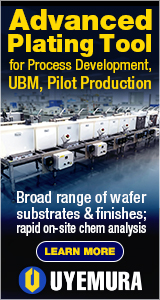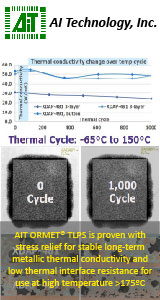|

|
|
| Ask the Experts | |||||||
|
|||||||
|
April 23, 2022 - Updated July 4, 2007 - Originally Posted Cleaning an assembled board with IPAIf the PCBA is cleaned with IPA to remove the no-clean flux residue, will the IPA residue on the PCBA cause a potential electrochemical migration problem over time? If not, what kind of test is recommended to confirm? SIR test? S.L. Lee |
|||||||
| Expert Panel Responses | |||||||
|
The short answer is, almost certainly yes, the residues will cause a problem. But the detailed answer is much more complex. Let's take a look at the question, step by step: 1. Most people don't know that pure IPA alcohol leaves almost no residues. By itself, high-quality IPA is a very clean material and if properly packaged, handled and used it can be expected to produce no more than 200-400 ppm of residues, and almost all of those residues are actually from the packaging. The bad news is that very, very few people buy high quality IPA. IPA is considered a commodity, so everybody wants a low price, so they buy the cheapest IPA on the market. These materials often are highly diluted (usually with water of uncertain origins) to lower the selling price. Products like these will not deliver high quality, reliable cleaning. 2. The migration to lead-free materials has made the cleaning situation worse, not better. IPA saturates at about 2% by weight, so if you had 100 kilos of exhausted, dirty IPA you would only be carrying about 2 kilos of flux residues. That's not very much. In addition, IPA has a fairly low "K-B value" of about 50 (sources differ on the exact rating) which is the measure of "cleaning horsepower." Lead-free materials typically require higher temperatures, longer process times and more active fluxes. These all lead to difficult cleaning situations, requiring higher Kb values, and old-fashioned IPA simply lacks the cleaning strength to handle these contaminates. 3. Most engineers try to select the best solvent but allow their operators to use the solvent in a dirty "Menda" style bottle, often with a dirty acid brush (see photo). So even if the solvent was high-purity material, it will be contaminated and recontaminated before it ever gets on to the PCBA. The best answer is to replace the IPA with a more modern, stronger, faster-drying solvent that delivers more cleaning power to the PCBA. I recommend the HFC-based cleaners or the HFE-based cleaners marketed by TechSpray, Chemtronics, Micro Care and others. In general, only those solvents will have the "muscle" to remove the lead-free no-clean residues in a quick and efficient manner. In addition, I would recommend an improved solvent delivery system, such as those produced by Miller-Stephenson or Micro Care, to reduce solvent consumption, eliminate waste and improve the cleaning process. These tools allow operators to wet the substrate, scrub the substrate, and then rinse the contamination from the board quickly, and without a lot of wasted solvent. Remember this: if you can't rinse, you can't clean. As for the testing, your best results will be obtained from 28-day SIR testing. This is a long and expensive process, so my strong suggestion would be to develop the best process you can and then merely validate the process with standardized SIR testing. Old-style "Omega meter" testing, which uses a DI-water bath and sensors to meaure halites in the water, is less precise but a whole lot cheaper and faster; it may be sufficient for some applications.
Vice President Micro Care Mr. Jones is an electronics cleaning and stencil printing specialist. Averaging over one hundred days a year on the road, Mike visits SMT production sites and circuit board repair facilities in every corner of the globe, helping engineers and technicians work through the complex trade-offs today's demanding electronics require.
Different no-clean solder pastes produce different residues with different characteristics. You are taking the right approach in checking the compatibility. To be sure the IPA will clean the residue, an SIR test is a good method. You should also be sure to use the same reflow profile for the SIR boards as will be used in the production. You are also going to want to make sure the cleaning method is enough to remove the residues. A simple wipe or "squirt" of IPA is unlikely to remove no-clean residues. If you are using a cleaning system you may also want to look into cleaning chemistries designed to clean no-clean residues. There are several companies that manufacture both solvent based and aqueous compatible chemistries that will have a much better chance of success than an IPA wash.
Application Engineering Henkel Electronics Dr. Brian Toleno is the Application Engineering Team leader for Henkel Technologies. He is responsible for the technical service and application engineering for Henkel's electronics assembly materials, including solder paste, underfills, PCB protection materials, and underfills.
With a no-clean residue, it is best to either leave the residue uncleaned or insure that the residue is removed completely. Without knowing the exact composition of the flux, it is tough to predict if an IPA cleaning process will completely remove the residue. I would suggest cleaning the residues with your typical IPA process and performing an ionic cleanliness test on the cleaned assemblies to assure yourself that the board is free from any ionic material. If the boards are completely cleaned, IPA should completely evaporate over time and no "residue" would be present. IPA does not leave a residue unless there was some sort of solid material dissolved in it that is not removed from the assembly when the IPA evaporates.
General Manager - Electronic Assembly Americas DEK International Mr. Smith has been supporting customers in the electronics assembly industry since 1994. His expertise is focused on solder paste printing and reducing soldering defects. He holds a BS in Chemical Engineering and an MBA in Marketing. He has authored several papers in trade magazines and at industry conferences. He is an SMTA Certified Process Engineer.
Cleaning no-clean is not normally recommended but there are times it is necessary. IPA is not a good cleaner. A cleaner that is compatible with the no-clean should be used. Most cleaner/ solvent suppliers will have cross reference of recommended products to clean a specific no-clean. Since IPA is not a good cleaner and depending on the no-clean you could strip an encapsulating part of the flux off and leave active material exposed. This then would reduce the SIR values and possibly lead to dendrite growth. The best test to run would be SIR and electro migration to verify your process.
Deck Street Consultants In his 32 years of industry experience, Mr. Seelig has authored over 30 published articles on topics including lead-free assembly, no-clean technology, and process optimization. Karl holds numerous patents, including four for lead-free solder alloys, and was a key developer of no-clean technology.
IPA is not capable of removing "no-clean" flux residues properly. Using IPA will result in leaving either partially cleaned (white powder) or untouched flux residues. Furthermore, should the same IPA solution be used for board rinsing purposes, the customer will experience long term climatic reliability issues. Those problems usually occur when IPA is loaded up with contaminants that could redeposit on the board surface. To reduce this redeposition phenomenon, the operator will have to make use of fresh IPA to rinse off the boards. Proper cleaning of the board can then be measured by using a ionic contamination tester. To further assess the cleanliness level of the assemblies we recommend the following test procedures: Flux Test, Visual Microscopic Inspection, Ionic Chromatography, Impedance Spectroscopy, SEM (Scanning Electron Microscope), Core Test.
Application Technology Manager Zestron America Mr. Tosun has published numerous technical articles. As an active member of the SMTA and IPC organizations, Mr. Tosun has presented a variety of papers and studies on topics such as "Lead-Free Cleaning" and "Climatic Reliability".
|
|||||||
| Submit A Comment | |||||||
|
Comments are reviewed prior to posting. You must include your full name to have your comments posted. We will not post your email address. |
|
Free Newsletter Subscription
Circuitnet is built for professionals who bear the responsibility of looking ahead, imagining the future, and preparing for it. Insert Your Email Address |
|

|







